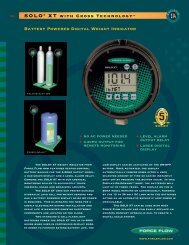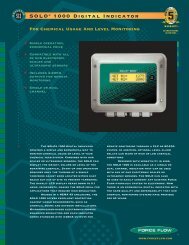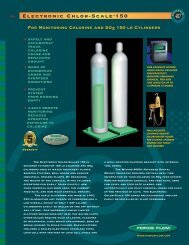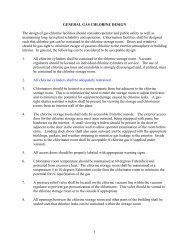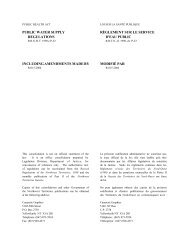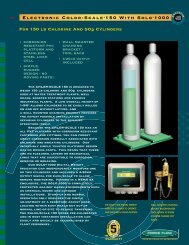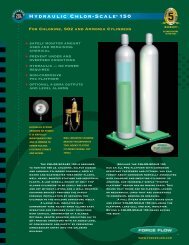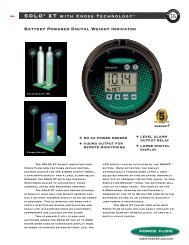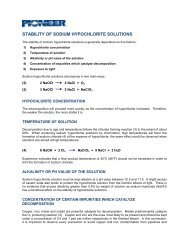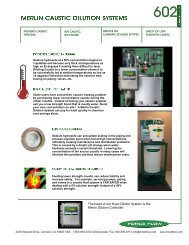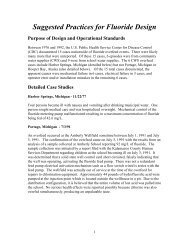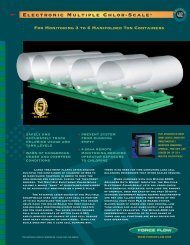Sodium Hypochlorite Handbook - Force Flow
Sodium Hypochlorite Handbook - Force Flow
Sodium Hypochlorite Handbook - Force Flow
Create successful ePaper yourself
Turn your PDF publications into a flip-book with our unique Google optimized e-Paper software.
ionic total strength increases the decomposition rate. In practice, a factor of 2 decrease inconcentration produces nearly a factor of 5 decrease in decomposition rate at any given temperaturewith a pH range of approximately 11 to 13.One other important concept in bleach decomposition is that due to the total ionic strength, once a 200gpl available chlorine solution decomposes to a 100 gpl solution, the 200 gpl decomposition rates aremuch greater than a 100 gpl available chlorine solution. Therefore, for any given strength andtemperature, over time the higher strength product will eventually be lower in available chlorine strengththan the lower strength product since it’s decomposition rate is greater.The reason this rate of decomposition must be understood by the consumer is that typically sodiumhypochlorite is delivered at approximately 120 gpl or 160-gpl available chlorine depending on the locallyit is produced and sold. Due to the basic chemistry of sodium hypochlorite, 160 gpl will decomposeapproximately 1.8 to 2.0 times faster than 120-gpl sodium hypochlorite and therefore chlorates will begenerated much more quickly. Since sodium hypochlorite and chlorate is always an issue in the finalproduct, then the specified delivered bleach should always be the lowest practical strength the suppliercan manufacture and deliver cost effectively.It is critical for the consumer to carefully specify the strength of sodium hypochlorite to be purchased.The length of storage time and temperature must determine the strength chosen. If the consumer isusing the product in an application that chlorate levels are critical, the chlorate formation must also beconsidered.Typically, for any storage over one week it is advisable for the end user to greatly reduce thedecomposition of the stored product. One of the best methods to reduce decomposition is to store thesodium hypochlorite at a lower strength than the delivered strength. The product must be diluted withsoft water. Plant water, well water, or city water must not be used in order to prevent the addition of thetotal dissolved and suspended solids and other contaminants with the untreated water. If 60 gplsodium hypochlorite is stored in lieu of 120 gpl, the rate of decomposition is decreased by a factor ofapproximately 5.Another benefit the consumer can receive is reduced cost of transportation. Since 160 gpl availablechlorine has 1/3 more available chlorine than 120 gpl, more available chlorine can be transported pershipment if purchased at the 160 gpl strength. Therefore, if high strength sodium hypochlorite isproduced and then diluted at the consumer’s site, the price per pound of available chlorine can bereduced.In many parts of the US and Canada and in many other parts of the world, higher strengths of bleachare available from the producer such as 180 gpl available chlorine and if so, even higher reduction incosts can be expected if the consumer can add the soft water in the storage tanks.2.4.2.2 Method #2 to Reduce <strong>Sodium</strong> <strong>Hypochlorite</strong> DecompositionChlorate Formation Path #2It is common in many small installation systems of sodium hypochlorite tanks to only have one tank forstorage. It is also common to leave some amounts of residual bleach in the storage tanks and thenwhen a new delivery of sodium hypochlorite is received, the new bleach is mixed into the existing oldbleach. This is not an acceptable practice.



